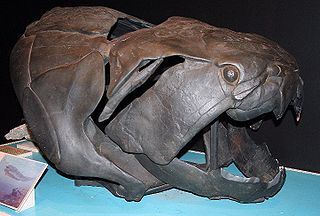
Dunkleosteidae is an extinct family of arthrodire placoderms that lived during the Devonian period. The gigantic apex predator Dunkleosteus terrelli is the best known member of this group.

Rolfosteus is an extinct monospecific genus of arthrodire placoderm from the Early Frasnian stage of the Late Devonian period, found at the Gogo Formation of Western Australia.
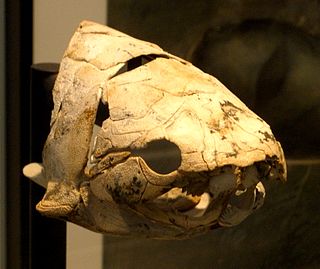
Eastmanosteus is a fossil genus of dunkleosteid placoderms. It was closely related to the giant Dunkleosteus, but differed from that genus in size, in possessing a distinctive tuberculated bone ornament, a differently shaped nuchal plate and a more zig-zagging course of the sutures of the skull roof.

Mcnamaraspis is an extinct monospecific genus of arthrodire placoderm that inhabited the ancient reef system of north Western Australia during the Frasnian epoch of the Late Devonian period. The type specimen was found and described by John A. Long from the Gogo Formation near Fitzroy Crossing. This fossil fish showed new anatomical features in arthrodires, like the well-preserved annular (ring-shaped) cartilages of the snout, previously inferred to be present by Erik Stensiö of Sweden. It is occasionally referred to as "The Gogo Fish" after the locale the holotype was excavated from.

Selenosteidae is an extinct family of small to large-sized arthrodire placoderms from the Late Devonian. With the exception of the Chinese Phymosteus, selenosteids lived in shallow seas in what is now Eastern North America, Eastern Europe, and Northeastern Africa.
Camuropiscidae is a family of mostly small, bullet or spindle-shaped extinct arthrodire placoderms from the Late Devonian. With the exception of the snub-nosed Simosteus, camuropiscid placoderms are characterized by an elongated, tubular snout. The entire family is restricted to the Frasnian Gogo Reef Formation of Australia.

Fallacosteus is an extinct monospecific genus of arthrodire placoderm from the Early Frasnian stage of the Late Devonian period, found at the Gogo Formation of Kimberley, Western Australia. As with almost all other camuropiscids, F. turneri had an elongated snout that may have enhanced its hydrodynamic streamlining.

Tubonasus is an extinct monospecific genus of long-snouted arthrodire placoderm from the Early Frasnian stage of the Late Devonian period, found at the Gogo Formation of Kimberley, Western Australia.

Draconichthys elegans a selenosteid arthrodire placoderm from the Late Frasnian Kellwasserkalk facies of the Anti-Atlas Mountains of what is now Morocco. During the Late Devonian, the region would have been a shallow, algae-dimmed sea.

Hadrosteus is an extinct monospecific genus of large arthrodire placoderm from the Late Frasnian Kellwasserkalk facies of Bad Wildungen, Germany. It had large, double-pronged inferognathals, and serrated edges along its mandible, strongly suggesting that it was a fish-eating predator. The head had a triangular snout, and the trunkshield was short, but high, with a median dorsal plate that was broader than wide. The average skull length is about 16 centimeters.

Stenosteus is an extinct monospecific genus of medium-sized selenosteid arthrodire placoderms of the Late Devonian period known from the Upper Famennian Cleveland Shale of Ohio. Estimated skull lengths range from 6 to 9 centimeters Most fossils of Stenosteus have been scraps of armor and portions of tooth-plates suggestive of Selenosteus. In 1996, enough material of a new species, S. angustopectus, was recovered to allow a reconstruction of armor that resembles that of Selenosteus.
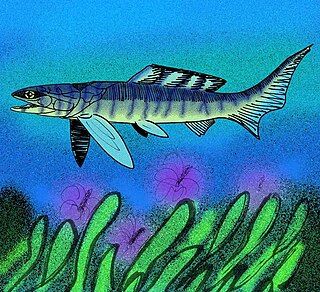
Gymnotrachelus is an extinct monospecific genus of large selenosteid arthrodire placoderm of the Late Devonian known from the Late Famennian Cleveland Shale of Ohio. The type species Gymnotrachelus hydei was originally reconstructed as physically resembling Selenosteus, with slightly smaller orbits. Later specimens led to a reappraisal, and now G. hydei is thought to have a more gar-like or barracuda-like build.
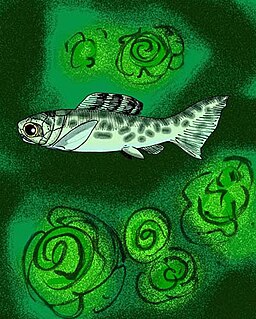
Microsteus is an extinct genus of small selenosteid arthrodire placoderms known from the Upper Frasnian Kellwasserkalk facies of Late Devonian Germany.

Enseosteus is an extinct genus of small selenosteid arthrodire placoderms known from the Upper Frasnian Kellwasserkalk facies of Late Devonian Germany and Morocco.

Rhinosteus is an extinct genus of small to medium selenosteid arthrodire placoderms of the Late Devonian known from the Upper Frasnian Kellwasserkalk facies of Bad Wildungen, Germany and Morocco.

Melanosteus is an extinct genus of small selenosteid arthrodire placoderms of the Late Devonian period known from the Upper Frasnian Montagne Noire of Southern France. Rücklin (2011) regards Melanosteus as the sister taxon of Rhinosteus. During the Frasnian stage, Melanosteus occitanus lived off the coast of an island continent, "Armorica," which consisted of portions of what would become Southern France.
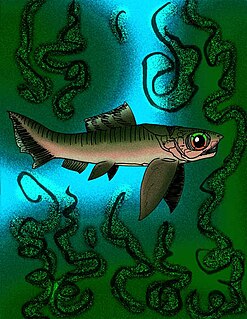
Braunosteus schmidti is a medium-sized selenosteid arthrodire placoderm known from the Upper Frasnian Kellwasserkalk facies of Late Devonian Bad Wildungen, Germany. B. schmidti has a broad skull about 9 centimeters long, and a short, but pointed rostrum. Its appearance is very similar to that of the basal selenosteid Pachyosteus.

Walterosteus is an extinct genus of small selenosteid arthrodire placoderms known from the Upper Frasnian Kellwasserkalk facies of Late Devonian Germany and Morocco.
Compagopiscis is an extinct genus of placoderm known from the Gogo Formation. It lived in the Upper Devonian of Western Australia. Compagopiscis is one of the earliest known vertebrates to have teeth. The genus is monotypic, with its only species being Compagopiscis croucheri.
Tapinosteus is an extinct monospecific genus of arthrodire placoderm from the Late Frasnian stage of the Late Devonian period. Fossils are found from Bad Wildungen, Germany.


























